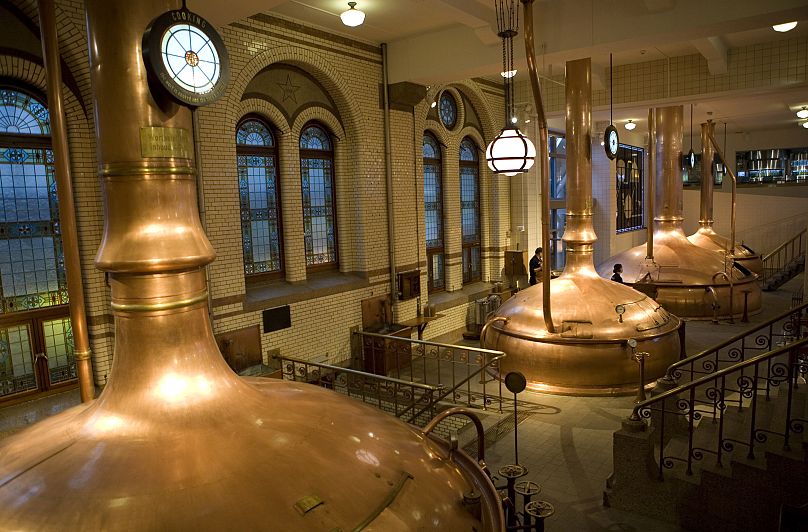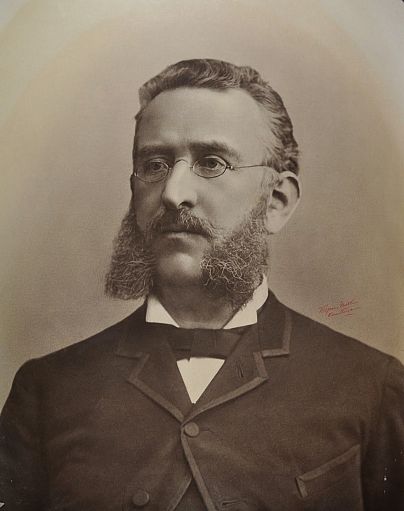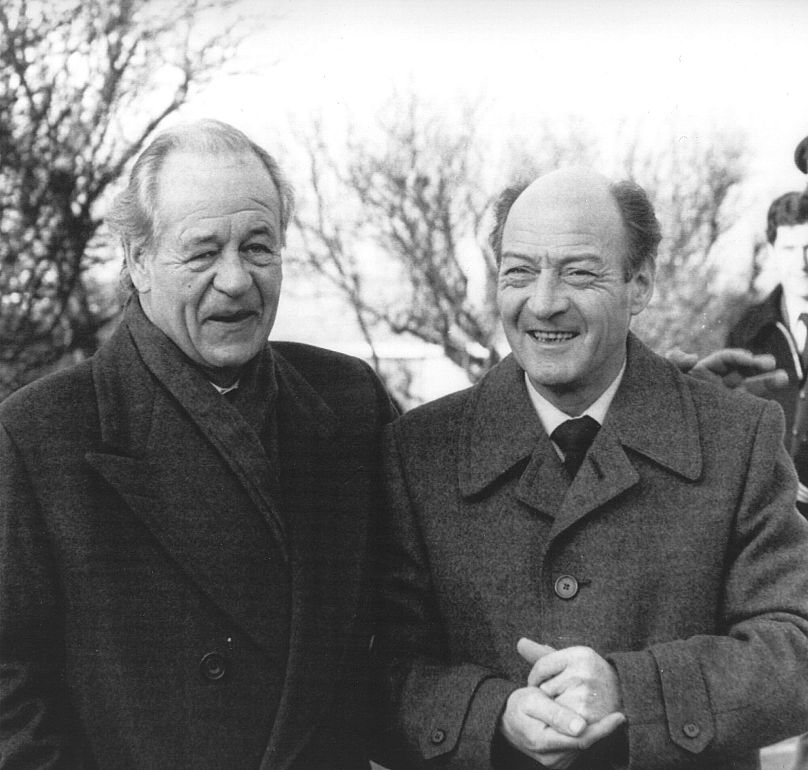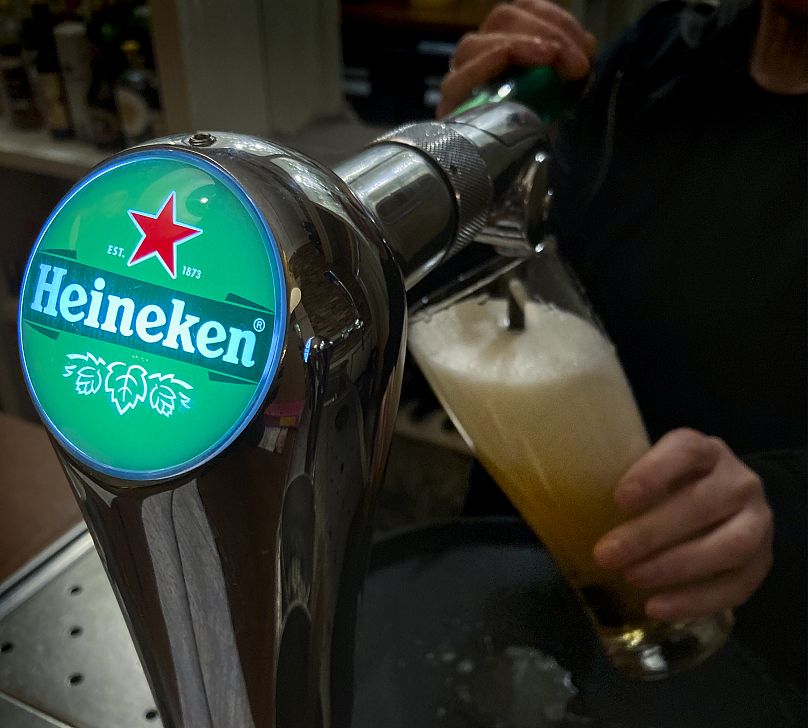For the 150th anniversary of the founding of Heineken, Euronews take a tour of the brewery in Amsterdam to get to the bottom of their famous green beer bottles.
"Gezellig”. It’s one of those untranslatable words like “Hygge” in Danish and Norwegian or “Kintsugi” in Japanese. The Dutch word “gezellig” means something leaning towards “cosy” in English but it’s true definition is broader than that. The Dutch use “gezellig” to describe a quiet Autumn evening cuddled up by the fire just as easily as they’d use it when arriving at a raucous boat-party with all their school friends in the height of Summer.
So far, so untranslatable. But it’s a word that keeps popping up as we tour the Heineken brewery in Amsterdam ahead of the company’s 150th anniversary. Why is this Dutch concept of pleasant enjoyable living so key to a major beer brand? It starts with its history.
Gerard Adriaan Heineken was in his early twenties when he first got involved in the alcohol business, buying the centrally-located De Hooiberg (The Haystack) brewery in 1864. After pleading with his mother for extra funds to establish his own brand, the Heineken brand was truly born in 1873 in a new brewery on the outskirts of the city.
Today, that same brewery is the Heineken Experience, a slick tourist experience taking you through the process of brewing one of the world’s most popular beers. No longer on the outskirts, the Heineken Experience is at the centre of a far bigger Amsterdam, heralding the border between the hip De Pijp neighbourhood and the touristic old city.
By some beer brand’s standards, it’s a relative newcomer with its late 19th century establishment. In the 150 years since Gerard Adriaan established the company, its rise in the beer world has been meteoric. Just two years after it was established, the beer won the Medaille D’Or at the international exhibition in the Paris Palais d’Industrie. This early acclaim for the beer was so important to Gerard Adriaan that the medal’s two faces are still emblazoned on Heineken bottles to this day.
“At the time, he found that the quality of beers around Amsterdam and around the Netherlands was not good enough,” explains Global Brand Director, Bram Westenbrink. All Gerard Adriaan wanted was a good beer, Westenbring says, so he employed Dr Hartog Elion, a disciple of Louis Pastor, the chemist who made major discoveries in the fields of vaccines, fermentation and pasteurisation.
Elion brought Gerard Adriaan what he was looking for. In 1886, Elion cultivated A-Yeast, a unique strain of yeast that combined with the simple ingredients barley, hops and water forms the unmistakable flavour of Heineken. Willem van Waesberghe, the Global Master Brewer for the company, insists that there is an aroma reminiscent of bananas in the beer.
Although I’m not sure I can detect that specific flavour, Van Waesberghe is one of the first exponents of that “gezellig” feeling as we delve into the history of the Heineken brewery. From a family of brewers, Van Waesberghe is a tall and broad man with a white beard reminiscent of Santa and an avuncular tone that draws you in. He pours glasses of Heineken out freely for everyone but watch him closely and you notice he’s never flippant about his own drinking experience. With every sip, he deftly rotates the glass, closes his eyes, inhales deeply before sipping. Once he’s satisfied, he returns to the room, ever joyful to provide more beer to friends new and old.
Van Weasberghe is the leading example of Heineken’s Master Brewers, a title that requires eight years of experience learning the Heineken trade. He explains that this is necessary because the scale of the Heineken operation means it cannot just be produced in the Netherlands. With breweries set up around the world all using local water with its varying qualities, Heineken demands a high level of expertise before a Master Brewer can sign off that a new brewery’s beer is up to par.
How Heineken became such a global brand comes down to the work of Gerard Adriaan’s successors. His son, Henry Pierre Heineken took over the business in 1917 and oversaw the company's growth in scale. While Gerard Adriaan was happy for the flavour of the beer to speak for itself, Henry Pierre first entered the foray of marketing the brand — a move that would define its future.
In 1928, as the Olympics came to Amsterdam, Henry Pierre thought of a PR stunt. He hired a group of retired First World War fighter pilots to write “Heineken” in the air above the stadium. “Everybody in the stadium was talking about it. It was written about in newspapers. They repeated it several times in the Netherlands, because everybody would want to see it,” explains Olaf Slijkhuis, a Digital Asset Curator who acts as a historian for Heineken.
Just five years later in 1933, anticipating the boon to European brewers, Henry Pierre made sure that the first boat to arrive in the US post-prohibition was one with a delivery of Heineken beer. Then, in 1939 they created a model Dutch village at the New York World Fair to further promote not just their beer but gezellig too. “The New York World's Fair in 1939 was all about science fiction. It was very modern and then we have this old Dutch village in the middle of it,” says Slijkhuis. The American view of the Netherlands was of tulips and windmills, afterall. “It was immensely popular,” Slijkhuis assures.
When Henry Pierre’s son Alfred Henry "Freddy" Heineken took over in 1940, his entire focus was on building the brand of the now-global beer. Freddy had spent time in New York taking marketing courses and quickly set to work, standardising the beer’s branding to have one label. One subtle change he made was to soften the font and turn the “E”s in the name so that they appear to smile at potential drinkers as an invitation.
Today, the company is owned by Freddy’s daughter, Charlene de Carvalho-Heineken. Behind AB InBev, they are the second largest beer company on the planet with a portfolio that includes over 300 brands, including fellow Dutch beer Amstel, as well as international favourites like Birra Morretti and Lagunitas.
“Freddy Heineken, he would always say, ‘we don't sell beer, we sell gezelligheid’,” Westenbrink says. “If you have a gezellige avond, it's not a nice evening, it's better than nice. It's about warmth and it's about good times.”
Despite the fascinating history, what’s remarkable is that this feeling of gezellig, or gezelligheid, is all anyone wants to speak about in the run-up to the brand’s 150th. The company is a hugely profitable enterprise and its sponsorship of massive sports events in Formula 1, Rugby and Football, only work to further the brand recognition. Even the Heineken Experience in Amsterdam, as fun a tour as it is through the history of its brewing process, is ultimately a form of advertising.
Yet as it comes to the 150th anniversary of potentially the world’s most recognisable beer brand, everyone’s focus is far from history or advertising. It’s on gezelligheid. “We're really proud of our history, we have a beautiful history. We could tell great stories about our history but what we really care about and what consumers really care about is having good times. So we don't really mind how consumers spell us, if consumers give us the wrong name, as long as they have a good time with us,” Westenbrink says.
Later, after leaving the Heineken Experience, we take a canal ride through Amsterdam and order a couple of beers — Heinekens, naturally. Suddenly, Westenbrink’s air of quiet marketing confidence makes sense. Why bore people with the details? A cold beer on a sunny day really is all you need.
Check out the video above to watch our full experience touring the Heineken Brewery.















